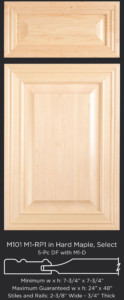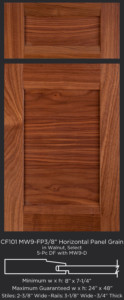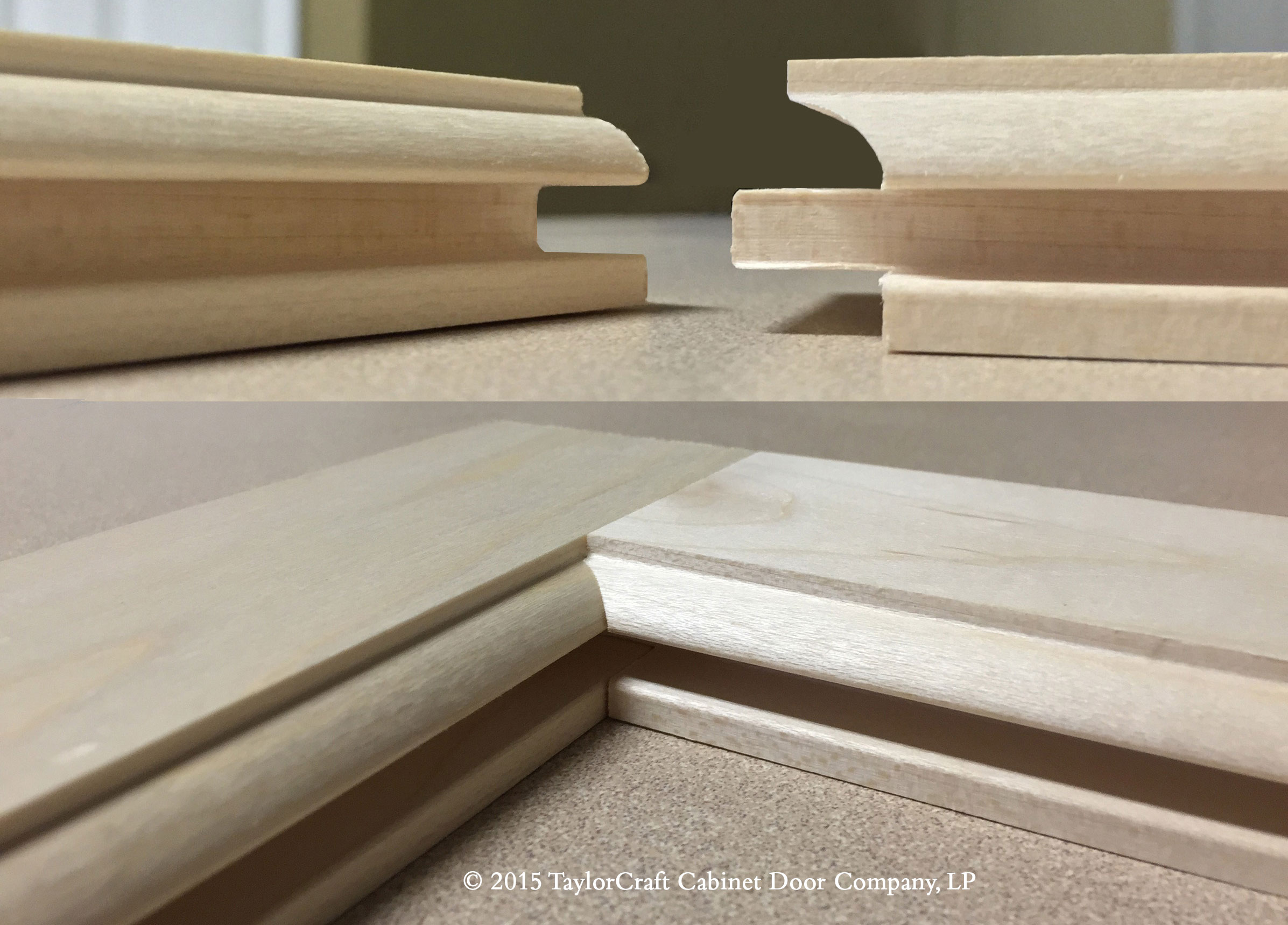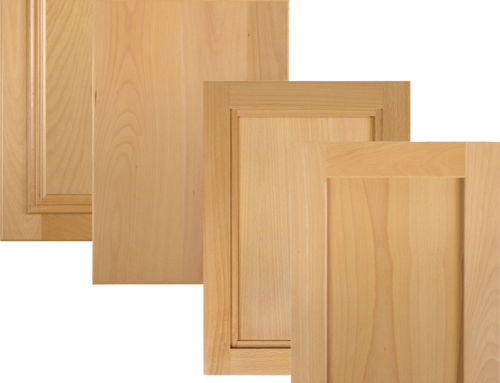Which Cabinet Door Style Should I Choose is a question we see frequently in kitchen and bath design forums. There are thousands of cabinet door styles and options, and if you’re undertaking a new kitchen design project or remodel you want to make informed choices you will be happy with for years and that portray your unique sense of style. Use our cabinet door style and construction guide to help make your selection, and as a starting point for dialogue with your cabinetmaker. We welcome your questions and feedback. For additional questions you should ask and style guidelines to consider, check out our Cabinet Door Buyers’ Guide.
Be sure to read our article on Cabinet Construction Options to learn more about the differences between faceframe and frameless cabinet construction and full overlay, partial overlay and inset cabinet doors.
Cabinet Door Construction
Mitered cabinet doors are built with stiles and rails meeting at a 45 degree angle at the corners. This construction method allows the frame detail to flow all the way around the door so a more detailed frame can be created. Because of the precision required to make the frame detail match up at all 4 corners, mitered cabinet doors can be more expensive than cope and stick. Mitered cabinet doors can be created with a blind mortise and tenon joint where you can’t see the joinery at the corner. In some construction methods you see the joinery at the corners. CNC blind mortise and tenon joints use the existing material for the tenon. This is beneficial during expansion and contraction because the tenon is the same piece of material as the frame. Some tenons are made of different material than the frame which becomes a weaker joint over time due to contraction and expansion.
On Cope and Stick doors the stiles and rails meet at the corners at a 90 degree angle and the frame detail is limited to the outside edge and inside edge of the frame.
Modern slab doors are made up of veneered hardwood over an MDF core for stability with outside edges edgebanded with 1.5mm to 3mm thick veneer tape to cover the raw MDF edge. Solid wood slab doors are less common and are made up of solid pieces of lumber glued side by side horizontally or vertically. Because of the lack of a supporting frame, solid wood slab doors are prone to warping and twisting so manufacturers willing to make them add battens (typically two or more pieces of lumber screwed in perpendicular to the wood on the face of the door) on the back of the doors for stability.
Applied Molding Cabinet Doors can be made either cope and stick or mitered construction with a decorative molding applied to the inside edge or the face of the door for extra detail and a more 3-dimensional end product.
Mullion (Divided Lite) Cabinet Doors are made with horizontal and vertical mullions in place of a solid panel to allow visibility to cabinet contents and provide decorative detail. Clear glass inserts are typically installed behind the mullions to keep dust out of cabinets. Sometimes decorative seeded, swirled, frosted or colored glass is used to give a period look, decorative touch or to obscure cabinet contents.
Cabinet Door Style Options – click on any of the links below to see a variety of cabinet doors in that style
Asian inspired kitchens are characterized by natural materials such as wood, river rock, granite and bamboo, clean lines, open space, eco-friendly materials, cabinet door styles with square inside and outside frame detail and doors with center mullions similar to Japanese shoji screens. Calming colors found in nature as well as very dark stains work well. Pops of strong colors such as red, which signifies energy and luxury, are fine if used in moderation so they don’t cause restlessness/anxiety.
Contemporary and Modern Cabinet Doors
Contemporary or modern kitchens are minimal in embellishments and counter top accessories, and cabinet doors tend to be angular designs with little ornamentation or slab edgebanded veneer. Popular modern cabinet door designs have an angled inside edge and square outside edge. Horizontal panel grain creates a more contemporary look.
Farmhouse kitchens tend to be painted white or a very light color with natural wood elements such as butcher block countertop brought in as accents. Light blue or green painted furniture-style islands, built-in hutches or accent cabinets are also common. Accessories such as pot and pan racks, pitcher collections shown through glass cabinet doors and vintage art and cooking implements also help define the farmhouse look. Cabinet doors range from traditional raised panel cope and stick designs to simple flat-panel shaker style doors.
Mediterranean kitchens are influenced by the decor of the countries bordering the Mediterranean Sea, namely Spain, Italy and Greece. These designs vary but typically contain colors influenced by the sea, sky and earth including blue and green and soft, earthy coral and terra cotta accents. Cabinet door designs often include organic shapes such as arched top rails and bullnose or ogee edges as well as open louver doors that allow air to circulate through the cabinet. Radius doors also work well in Mediterranean design. Mosaic tile and painted-tile backsplashes with blue, green, terra cotta and yellow patterns are common.
Mid Century kitchens typically featured natural wood cabinets, natural stone floors, clean lines and rounded and smooth edges. Mid century cabinet doors often were 1-piece construction with no separate panel or applied molding and were most often slab doors with little detail. Cabinets often had horizontal wood grain and very simple hardware. Chrome hardware and fixtures were also popular. Countertops were often white or a pale shade of green, yellow or blue. Turquoise and orange accents were also popular. White, plastic bar stools with chrome legs are another signature mid-century modern look.
As the name suggests, ornate kitchens are very detailed and typically contain accents such as corbels, moldings, carvings and hardware with finials. Ornate cabinet doors have detailed inside, outside and raised panel profiles including multiple steps, s-curves and waterfall edges. Mitered cabinet doors are a good fit for ornate rooms because of the ability to mould a significant amount of detail across the entire mitered frame.
Rustic cabinets are typically made using knotty material such as knotty alder, hickory or cherry with cabinet doors in cope and stick designs that are very simple with little edge and panel detail. Rustic kitchens often make use of natural wood finishes, natural iron and stone accents and open pot and pan racks.
Shaker Cabinet Doors – Craftsman Cabinet Doors
Shaker kitchen cabinets are characterized by their minimalism and simplicity and have cabinet doors with square inside and outside edge detail and flat, recessed panel with no ornamentation. Shaker doors are typically made using natural material, and common wood species include cherry, maple and pine. Shaker cabinets are sometimes painted white, blue, red, yellow or green with natural wood pulls. Mission and Craftsman style kitchens also have squared, unadorned detail but are typically made of red oak or white oak and sometimes contain exposed joinery with pegs or dovetail joints that show off the craftsmanship.
Southwestern kitchens often use chili pepper red, terra cotta orange or turquoise accent colors paired with natural alder or pine. Knotty or rustic wood is often used in cabinets and furniture. Open wood ceiling beams are popular and edges are often rounded and reflect Adobe architecture. Hardware is often wrought iron and accessories include local pottery, baskets, hand carved wood pieces, local art and brightly-colored, woven wool blankets and rugs. Cabinet door styles vary widely from flat panel cope and stick with little detail to raised panel, ornate southwest designs that reflect native American motifs.
Traditional rooms typically are very symmetrical in design with colors that vary from clean white, cream, classic blue, red and khaki to more subdued yellows, pinks and greens. Trim work and decorative molding is often used to dress up cabinets, and paneled cabinet ends and wainscot on walls and island backs create a finished, traditional look. Turned legs on cabinets and furniture style islands and hutches in a different color than the surrounding cabinets are also a popular traditional design element. Traditional cabinet door designs can vary greatly from red oak raised panel designs to painted, flat panel shaker.
Transitional kitchens typically contain traditional elements such as natural wood and stone paired with more modern design elements like clean lines and little ornamentation. TaylorCraft Cabinet Door Company’s flat-panel, combination frame cabinet doors with horizontal panel grain are a perfect fit for a transitional room.
Tropical – Beach Cabinet Doors
Beach and tropical kitchens typically use light wood such as maple or beech. Cabinet doors are made with soft, rounded inside and outsided edges, arches and sometimes open louvers. Common colors include sand, water and sky hues.
Victorian design, named after England’s Queen Victoria who reigned in the late 1800’s, is ornate and full of detail and embellishments. Characteristics include corbels, arches, carvings, furniture-style feet, separate kitchen cabinet pieces that look like furniture, a center table instead of an island and open shelves to display plates, cups, pots and pans. Victorian cabinet doors often contain applied moldings, arches and raised panels or divided lites with glass inserts and can be painted, stained or oiled wood.
More Cabinet Door Choices and Options
In addition to different construction methods, there are many style options including applied molding, horizontal vs vertical panel grain, wide frame vs narrow, doors with built-in fingerpull on the back edge vs square backs that require pulls or knobs on the door face. Be sure to discuss these options with your cabinetmaker and ask how material and style choices affect project cost.
Know the pros and cons of different materials. Some materials change color over time, some hold up better against dents and scratches. Read our articles on Alder vs. Cherry and Hard Maple vs. Soft Maple for information on material color, hardness, etc and read our Cabinet Door Hardware Placement Guidelines article to jump start your cabinet door hardware decisions.
Before you meet with a kitchen and bath designer or cabinetmaker, clip out magazine photos and save web pages with products you like. Know your style preferences as well as the style of your home and surrounding decor. Ornate, mitered applied molding cabinet doors may not be your best choice if all of your decor or architecture is mid-century modern.
We wish you the best on your project. Send us any questions or feedback on our Contact page and we will be happy to get back to you.
















